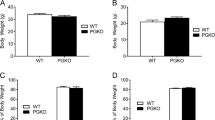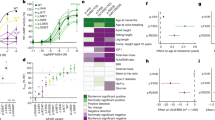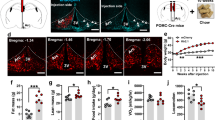Abstract
Genetic1,2,3,4,5,6,7,8 and pharmacological6,9,10,11,12 studies have defined a role for the melanocortin-4 receptor (Mc4r) in the regulation of energy homeostasis. The physiological function of Mc3r, a melanocortin receptor expressed at high levels in the hypothalamus13, has remained unknown. We evaluated the potential role of Mc3r in energy homeostasis by studying Mc3r-deficient (Mc3r−/−) mice and compared the functions of Mc3r and Mc4r in mice deficient for both genes. The 4–6-month Mc3r−/− mice have increased fat mass, reduced lean mass and higher feed efficiency than wild-type littermates, despite being hypophagic and maintaining normal metabolic rates. (Feed efficiency is the ratio of weight gain to food intake.) Consistent with increased fat mass, Mc3r−/− mice are hyperleptinaemic and male Mc3r−/− mice develop mild hyperinsulinaemia. Mc3r−/− mice did not have significantly altered corticosterone or total thyroxine (T4) levels. Mice lacking both Mc3r and Mc4r become significantly heavier than Mc4r−/− mice. We conclude that Mc3r and Mc4r serve non-redundant roles in the regulation of energy homeostasis.
This is a preview of subscription content, access via your institution
Access options
Subscribe to this journal
Receive 12 print issues and online access
$209.00 per year
only $17.42 per issue
Buy this article
- Purchase on Springer Link
- Instant access to full article PDF
Prices may be subject to local taxes which are calculated during checkout






Similar content being viewed by others
References
Krude, H. et al. Severe early onset obesity, adrenal insufficiency and red hair pigmentation caused by POMC mutations in humans. Nature Genet. 19, 155–157 ( 1998).
Chagnon, Y.C. et al. Linkage and association studies between the melanocortin receptors 4 and 5 genes and obesity-related phenotypes in the quebec family study. Mol. Med. 3, 663–673 ( 1997).
Yeo, G.S.H. et al. A frameshift mutation in MC4R associated with dominantly inherited human obesity. Nature Genet. 20, 111–112 (1998).
Vaisse, C., Clement, K., Guy-Grand, B. & Froguel, P. A frameshift mutation in human MC4R is associated with a dominant form of obesity. Nature Genet. 20, 113– 114 (1998).
Michaud, E.J. et al. A molecular model for the genetic and phenotypic characteristics of the mouse lethal yellow (Ay) mutation. Proc. Natl Acad. Sci. USA 91, 2562–2566 (1994).
Ollmann, M.M. et al. Antagonism of central melanocortin receptors in vitro and in vivo by agouti-related protein. Science 278, 135–138 (1997).
Graham, M., Shutter, J.R., Sarmiento, U., Sarosi, I. & Stark, K.L. Overexpression of Agrt leads to obesity in transgenic mice. Nature Genet. 17, 273–274 (1997).
Huszar, D. et al. Targeted disruption of the melanocortin-4 receptor results in obesity in mice. Cell 88, 131– 141 (1997).
Fan, W., Boston, B.A., Kesterson, R.A., Hruby, V.J. & Cone, R.D. Role of melanocortinergic neurons in feeding and the agouti obesity syndrome. Nature 385, 165–168 (1997).
Lu, D. et al. Agouti protein is an antagonist of the melanocyte-stimulating-hormone receptor. Nature 371, 799– 802 (1994).
Marsh, D.J. et al. Response of melanocortin-4 receptor-deficient mice to anorectic and orexigenic peptides. Nature Genet. 21, 119–122 (1999).
Chen, A.S. et al. Role of the melanocortin-4 receptor in metabolic rate and food intake in mice. Transgenic Res. (in press).
Roselli-Rehfuss, L. et al. Identification of a receptor for γ melanotropin and other proopiomelanocortin peptides in the hypothalamus and limbic system. Proc. Natl Acad. Sci. USA 90, 8856– 8860 (1993).
Johnson, P.R. & Hirsch, J. Cellularity of adipose depots in six strains of genetically obese mice. J. Lipid Res. 13, 2–11 (1972).
Yen, T.T., Allan, J.A., Yu, P.-L., Acton, M.A. & Pearson, D.V. Triacylglycerol contents and in vivo lipogenesis of ob/ob, db/db and Avy/a mice. Biochem. Biophys. Acta 441, 213–220 ( 1976).
Yen, T.T., Steinmetz, J. & Wolff, G.L. Lipolysis in genetically obese and diabetes-prone mice. Horm. Metab. Res. 2, 200– 203 (1970).
Jones, B.H. et al. Upregulation of adipocyte metabolism by agouti protein: possible paracrine actions in yellow mouse obesity. Am. J. Physiol. 270, E192–E196 (1996).
Xue, B., Moustaid-Moussa, N., Wilkison, W.O. & Zemel, M.B. The agouti gene product inhibits lipolysis in human adipocytes via a Ca2+-dependent mechanism. FASEB 12, 1391–1396 (1998).
Fekete, C. et al. α-Melanocyte-stimulating hormone is contained in nerve terminals innervating thyrotropin-releasing hormone-synthesizing neurons in the hypothalamic paraventricular nucleus and prevents fasting-induced suppression of prothyrotropin-releasing hormone gene expression. J. Neurosci. 20, 1550–1558 ( 2000).
Kim, M.S. et al. The central melanocortin system affects the hypothalamo-pituitary thyroid axis and may mediate the effect of leptin. J. Clin. Invest. 105, 1005–1011 ( 2000).
Frigeri, L.G., Wolff, G.L. & Teguh, C. Differential responses of yellow Avy/A and agouti A/a (BALB/c×VY) F1 hybrid mice to the same diets: glucose tolerance, weight gain, and adipocyte cellularity. Int. J. Obes. 12, 305–320 ( 1988).
Shimizu, H., Shargill, N.S., Bray, G.A., Yen, T.T. & Geselichen, P.D. Effects of MSH on food intake, body weight and coat color of the yellow obese mouse. Life Sci. 45, 543–552 ( 1989).
Hruby, V.J. et al. Cyclic lactam α-melanotropin analogues of Ac-Nle4-cyclo[Asp5, D-Phe7, Lys10] α-melanocyte-stimulating hormone-(4-10)-NH2 with bulky aromatic amino acids at position 7 show high antagonist potency and selectivity at specific melanocortin receptors. J. Med. Chem. 38 , 3454–3461 (1995).
Bagnol, D. et al. Anatomy of an endogenous antagonist: relationship between agouti-related protein and proopiomelanocortin in brain. J. Neurosci. 19, RC26 (1–7) (1999).
Gantz, I. et al. Molecular cloning of a novel melanocortin receptor. J. Biol. Chem. 268, 8246–8250 (1993).
Chhajlani, V. Distribution of cDNA for melanocortin receptor subtypes in human tissues. Biochem. Mol. Biol. Int. 38, 73–80 (1996).
Lembertas, A.V. et al. Identification of an obesity quantitative trait locus on mouse chromosome 2 and evidence of linkage to body fat and insulin on the human homologous region 20q. J. Clin. Invest. 100, 1240–1247 (1997).
Guan, X.-M., Yu, H. & Van der Ploeg, L.H.T. Evidence of altered hypothalamic pro-opiomelanocortin/neuropeptide Y mRNA expression in tubby mice. Mol. Brain Res. 59 , 273–279 (1998).
Kelly, T.L., Berger, N. & Richardson, T.L. DXA body composition: theory and practice. Appl. Radiat. Isot. 49, 511–513 (1998).
Ellis, K.J. Human body composition: in vivo methods. Physiol. Rev. 80, 649–680 (2000).
Acknowledgements
We thank D. Weinberg for providing rat Mc3r cDNA and J. Ronan for assistance in the histological evaluation of adipose tissues.
Author information
Authors and Affiliations
Corresponding author
Rights and permissions
About this article
Cite this article
Chen, A., Marsh, D., Trumbauer, M. et al. Inactivation of the mouse melanocortin-3 receptor results in increased fat mass and reduced lean body mass. Nat Genet 26, 97–102 (2000). https://doi.org/10.1038/79254
Received:
Accepted:
Issue Date:
DOI: https://doi.org/10.1038/79254
This article is cited by
-
Targeting the central melanocortin system for the treatment of metabolic disorders
Nature Reviews Endocrinology (2023)
-
Evaluation of the MC3R gene pertaining to body weight and height regulation and puberty development
Scientific Reports (2023)
-
Molecular cloning and functional characterization of melanocortin-3 receptor in grass carp (Ctenopharyngodon idella)
Fish Physiology and Biochemistry (2023)
-
The interaction of MC3R and MC4R with MRAP2a in rainbow trout (Oncorhynchus mykiss)
Fish Physiology and Biochemistry (2023)
-
Signaling pathways in obesity: mechanisms and therapeutic interventions
Signal Transduction and Targeted Therapy (2022)



